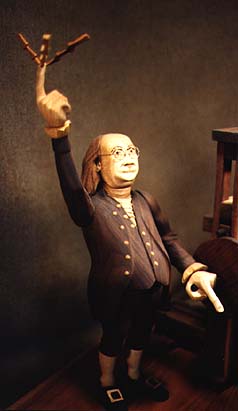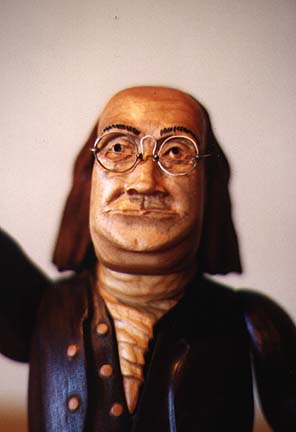Ben Brings Down the Lightning
 |
Ben Franklin was the First American, in the modern sense –– entrepreneur, individualist, polymath, revolutionary, self-publicist. Of course he was also a powdered diplomat and a ladies' man.
Like all Tricksters, he lived on the changing edge of his times, and you can never be sure when he was pulling our legs. Poor Richard's Almanac preached "early to bed and early to rise," but Ben wasn't above wheeling a barrow full of paper around town during lunchtime to make himself look industrious. Jacob Needleman in his recent book American Soul contends that Franklin's autobiography lays out, in a tongue-in-cheek manner, a model of "self-struggle" directed toward a "practical, experimental spirituality." Ben as an American Psychopomp. Why not a pragmatic guru for the American Seeker? |
| The genesis of this printing press design was an articulated portrait of Al Miller's father –– he was publisher of a chain of newspapers in the Mid West. That device had the publisher cranking the press and toasting us with a martini. Ben does one better and brings down the heavenly sparks.
The reciprocating rack and pinion gearing on the press bed makes a neat clatter as the plate goes up and down, the bed goes in and out, and Ben bows and arises. And the device is easily realigned with a touch when it jumps out of gear. I wish all my mechanisms worked as well. The message imprinted on the paper is E Pluribus Unum, surrounding the Pyramid and Eye from the dollar bill. Needleman says that Franklin's spiritual message is to "find a self-discipline that liberates our capacity to serve the common good." Then again, Ben said the slogan on the dollar should read: Mind Your Business. |
 |
 |
Each portrait is a study in period as well as iconography. I had to research Colonial costume to dress Ben up, but the most fun in the details was concocting his bifocals.
As far as the caricature, I was delighted to find that Franklin has such a prissy mouth. How those French Girls must have loved to bounce on his knee and kiss the Wild American. I showed this piece at the Maine Festival the year after I made it, and about a year later I got a call from a man named Franklin in Philadelphia who had heard about it. Now the piece lives in Pennsylvania, which seems apt. |